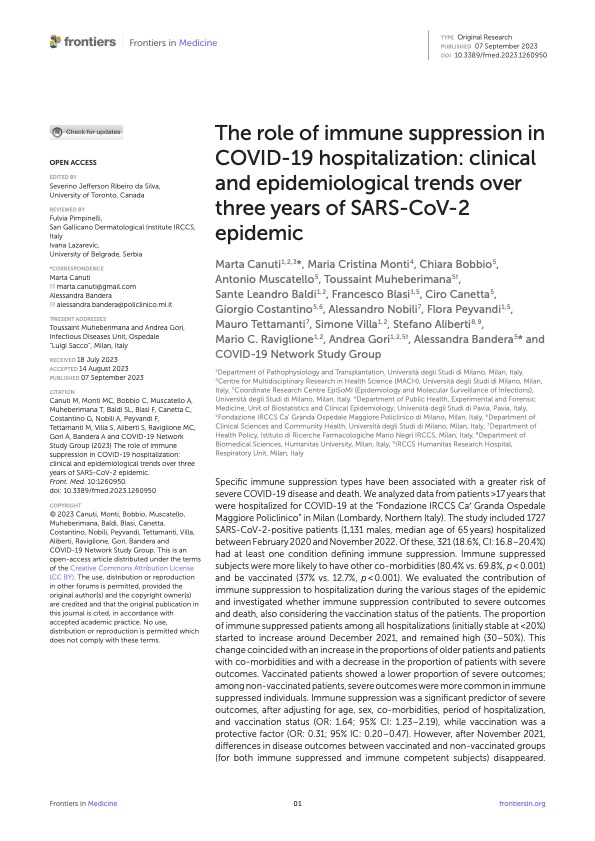Publication links
Abstract
Specific immune suppression types have been associated with a greater risk of severe COVID-19 disease and death. We analyzed data from patients >17 years that were hospitalized for COVID-19 at the “Fondazione IRCCS Ca′ Granda Ospedale Maggiore Policlinico” in Milan (Lombardy, Northern Italy). The study included 1727 SARS-CoV-2-positive patients (1,131 males, median age of 65 years) hospitalized between February 2020 and November 2022. Of these, 321 (18.6%, CI: 16.8–20.4%) had at least one condition defining immune suppression. Immune suppressed subjects were more likely to have other co-morbidities (80.4% vs. 69.8%, p < 0.001) and be vaccinated (37% vs. 12.7%, p < 0.001). We evaluated the contribution of immune suppression to hospitalization during the various stages of the epidemic and investigated whether immune suppression contributed to severe outcomes and death, also considering the vaccination status of the patients. The proportion of immune suppressed patients among all hospitalizations (initially stable at <20%) started to increase around December 2021, and remained high (30–50%). This change coincided with an increase in the proportions of older patients and patients with co-morbidities and with a decrease in the proportion of patients with severe outcomes. Vaccinated patients showed a lower proportion of severe outcomes; among non-vaccinated patients, severe outcomes were more common in immune suppressed individuals. Immune suppression was a significant predictor of severe outcomes, after adjusting for age, sex, co-morbidities, period of hospitalization, and vaccination status (OR: 1.64; 95% CI: 1.23–2.19), while vaccination was a protective factor (OR: 0.31; 95% IC: 0.20–0.47). However, after November 2021, differences in disease outcomes between vaccinated and non-vaccinated groups (for both immune suppressed and immune competent subjects) disappeared. Since December 2021, the spread of the less virulent Omicron variant and an overall higher level of induced and/or natural immunity likely contributed to the observed shift in hospitalized patient characteristics. Nonetheless, vaccination against SARS-CoV-2, likely in combination with naturally acquired immunity, effectively reduced severe outcomes in both immune competent (73.9% vs. 48.2%, p < 0.001) and immune suppressed (66.4% vs. 35.2%, p < 0.001) patients, confirming previous observations about the value of the vaccine in preventing serious disease.
Keywords
Citation
Canuti M, Monti MC, Bobbio C, Muscatello A, Muheberimana T, Baldi SL, Blasi F, Canetta C, Costantino G, Nobili A, Peyvandi F,
Tettamanti M, Villa S, Aliberti S, Raviglione MC, Gori A, Bandera A and COVID-19 Network Study Group (2023) The role of immune suppression in COVID-19 hospitalization: clinical and epidemiological trends over three years of SARS-CoV-2 epidemic.
Front. Med. 10:1260950.
doi: 10.3389/fmed.2023.1260950

